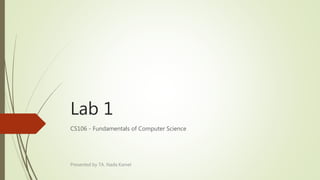
CS106 Lab 1 - Introduction
- 1. Lab 1 CS106 - Fundamentals of Computer Science Presented by TA. Nada Kamel
- 2. Agenda Types of programming languages Difference between High and Low programming languages What is a Compiler? Problem Solving Techniques Pseudo code Algorithm Flow chart Example Implementation Presented by TA. Nada Kamel
- 3. How People solve problems A Problem exists when what we have (Data) is not the same as what we want (Information) People create a solution (called an Algorithm) which manipulates Data into Information People do this quickly and often in a complex way Presented by TA. Nada Kamel
- 4. How Computers solve problems Computers also use Algorithms to solve problems, and change data into information Computers can only perform one simple step at a time Complex “Human” Algorithms must be broken down into simple step-by- step instructions BEFORE they can be translated into computer code Presented by TA. Nada Kamel
- 5. Programming Languages Presented by TA. Nada Kamel
- 6. Types of programming languages There are two types of programming languages based on the code or syntax they use.. Low Programming Language High Programming Language Presented by TA. Nada Kamel
- 7. Difference between programming languages The difference between them is on the way we write their code. For example, Assembly is a low-level language where the user writes code which is almost identical to the one computers understand. Presented by TA. Nada Kamel
- 8. High Programming Language A high-level programming language uses a more natural and human- readable syntax which makes it easier for humans to understand and write. Today, most programmers use some sort of a high-level language, because it is much easier to learn and understand and often requires much less work. For example, C++, C#, Java, e.t.c. Presented by TA. Nada Kamel
- 9. What is a Compiler? Presented by TA. Nada Kamel
- 10. Editor Presented by TA. Nada Kamel Source file Compiler Linker Object file Other object files Executable file Loader
- 11. Tools Editor to be used: Microsoft Visual Studio Windows Xcode Mac Presented by TA. Nada Kamel
- 12. Programming Phases A typical programming task can be divided into two phases: Problem solving phase Produce an ordered sequence of steps that describe solution of problem This sequence of steps is called an algorithm Implementation phase Implement the program in some programming language Presented by TA. Nada Kamel
- 13. Problem Solving Techniques Presented by TA. Nada Kamel
- 14. Problem Solving Problem Solving is the ability to understand what you have, what you want, and creating a set of instructions to change what you have into what you want Good Problem Solving Skills are based on knowledge, experience and logic Good Programmers NEVER make assumptions Presented by TA. Nada Kamel
- 15. Expressing an algorithm A “Standard” way of describing an algorithm must exist if we expect our solution to be understood by others easily There are standards in programming: PSEUDOCODE FLOWCHARTS PROGRAMMING LANGUAGE Presented by TA. Nada Kamel
- 16. Pseudo Code “Pseudo” means “pretend” or “false” Pseudo Code is pretend or false computer code; generic English-like terms that are somewhat like computer code Pseudo Code is not as standardized as flowcharts, and does not facilitate the breaking down of problems as well as a flowchart does Presented by TA. Nada Kamel
- 17. Flowchart Graphical representations of algorithms Tool to translate algorithms into software A Flowchart uses easy-to-understand symbols to represent actions on data and the flow of data Flowcharts aid in breaking down a problem into simple steps Presented by TA. Nada Kamel
- 18. Presented by TA. Nada Kamel
- 19. Flowcharting Presented by TA. Nada Kamel
- 20. Example Presented by TA. Nada Kamel
- 21. Example Write an algorithm to add 2 numbers. Presented by TA. Nada Kamel
- 22. Pseudo Code Read first number Read second number Add first number to second number Print result of addition Presented by TA. Nada Kamel
- 23. Algorithm and Flowchart Step 1: Input num1, num2 Step 2: result num1 + num2 Step 3: Print result Start Input num1, num2 result num1 + num2 Print result EndPresented by TA. Nada Kamel
- 24. Implementation Presented by TA. Nada Kamel
- 25. Implementation The code is divided into two parts: Libraries (such as <iostream>, <iomanip>, …) Body Declaration (int, float, char, string) User Input (cin) Processing Output (cout) Presented by TA. Nada Kamel
- 26. How to write the code of the problem? Presented by TA. Nada Kamel
- 27. Presented by TA. Nada Kamel using Visual Studio
- 28. Presented by TA. Nada Kamel using Xcode
- 29. Any Questions? Presented by TA. Nada Kamel
Editor's Notes
- Will be given in the next lab inshAllah.
- Will be given in the next lab inshAllah.
- Will be given in the next lab inshAllah.